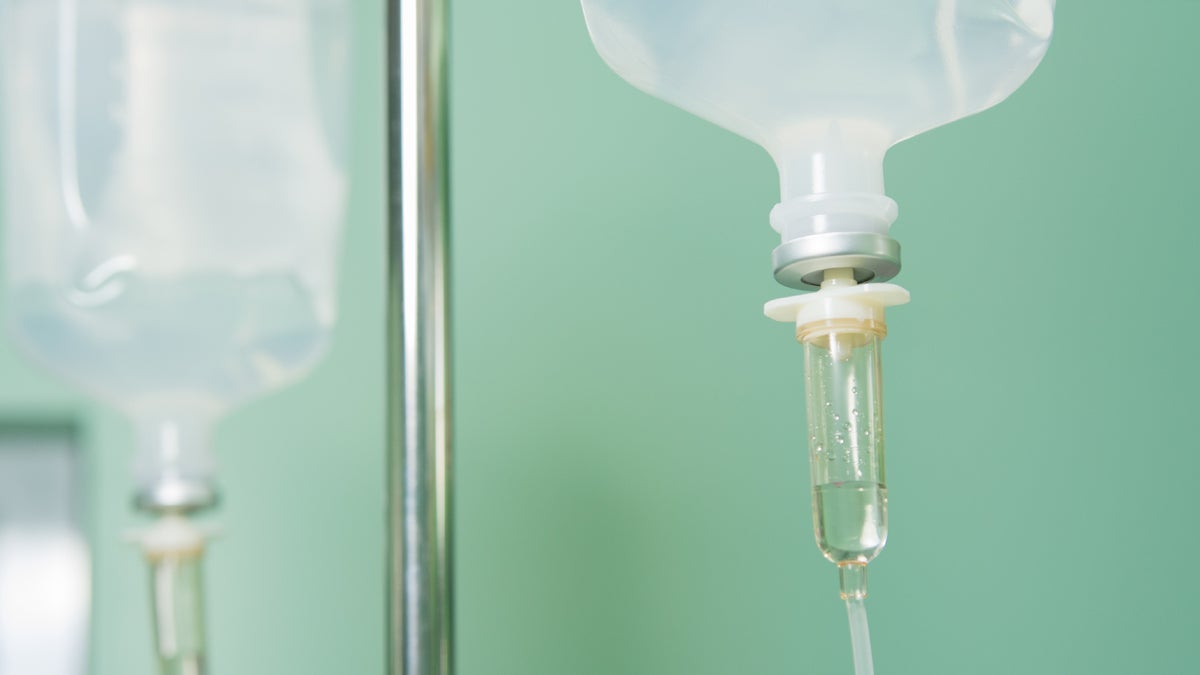Saline: A simple resource not always simple to come by
Listen
(Shutterstock photo)
Hospitals around the country are struggling with a shortage of one of their most relied upon fluids.
Reid Kennedy walks through the basement of San Francisco General Hospital. He’s in charge of managing all the gloves and bandages and bedpans that pass through here to the ER and OR. Kennedy winds through shelves stacked with cardboard boxes and stops at a special back room with a combination lock.
“IV solutions are under lock and key because they go in people’s bodies, so we have to keep them under lock and key,” says Kennedy. He calls it the secret squirrel chamber, and it’s where the hospital keeps its precious saline supply. “Saline is hugely popular. It’s just used everywhere, it’s used in wound management, it’s used in medication delivery, it’s used in hydration, it’s used, just everywhere.”
The patients upstairs wouldn’t know it, but Kennedy is dealing with a serious shortage of saline. He first got a call last year from his vendor telling him they might not be able to deliver his full order. “We were put on notice that it was going to be tight,” he says. Then things got worse in January when the flu season hit. Saline bags flew off the shelves to rehydrate patients. Demand far outstripped supply. Kennedy says it knocked them out.
But we’re talking about salty water here. So can’t drug companies just whip up some more?
“To make one of these drugs is very complex, even though the drug itself is simple,” says Valerie Jensen, the director of the drug shortage program at the FDA. “It takes about three weeks to make one batch of normal saline from start to finish.”
She says the key challenge is making sure saline products are sterile. If you swallow a pill with a little bit of dirt on it, you’ll probably be fine. But if a nurse injects saline into your vein that’s even a little bit contaminated, you have a big problem. Jensen says FDA inspectors have found some nasty things in a range of IV drugs, including “bacteria or mold, glass particles in the vials.”
That’s why the FDA sets strict quality standards for the facilities that manufacture saline and other IV drugs. But the agency has to find a delicate balance between safety and supply.
“During last year, all suppliers had issues within their facilities where they had to correct certain things the FDA found,” says Scott Crandall of Novation, a group buyer in Texas that manages saline contracts for San Francisco General and 2,000 other hospitals. He’s been hearing from manufacturers that increased FDA scrutiny is interfering with drug production.
But some of those things were serious. Hospira, one manufacturer of saline, issued a recall earlier this year because of leaks in its saline bags. Before that, Baxter found particles in its saline and had to recall four lots. Crandall says the company had to shut down its plant for weeks for maintenance.
“[Manufacturers] Slowed their production down—ten, twenty percent, are the numbers we’re being told, he says. Winter weather was a factor, too. Satellite Healthcare procurement director Colin Carthen says Baxter told him that snow and ice storms in the Midwest were delaying trucks headed for California.
“As the weather got worse, we began to see more and more back-order issues,” recalls Carthen. He oversees the saline supply for 70 dialysis centers across the US, including this one in Northern California. Each patient needs four liters a week to clean their blood during treatment for kidney failure. In the depths of the shortage, Carthen realized the health of six thousand patients was depending on him.
“I called up a clinical person that I knew, at like 11:30 at night and said, ‘Well, what happens if we run out of saline?’ Because I was really afraid, about what might happen. And they were just like, ‘Yeah, it gets ugly…fast.'”
Every day, Carthen says he spent hours juggling and rerouting supplies so everyone had enough. The FDA is trying to mitigate the shortage by importing saline from Spain and Norway. But FDA economist Marta Wosinska says that’s not a sustainable solution, since those countries have to supply their own hospitals.
“There is no spot market,” says Wosinska. “You can’t buy it like pork bellies or grains or oil. You cannot go on a marketplace and order a certain amount.”
Saline prices don’t really fluctuate either. Hospitals are protected under contracts that keep rates locked through next year. But Novation’s saline buyer Scott Crandall says all bets are off when those contracts expire. “The suppliers have already signaled to the market that they plan on increasing prices significantly. And when I say that, it could double and triple in some aspects.”
That means paying $2 or $3 dollars a bag, instead of $1, and it all adds up. But it still could be cheaper than what it costs to work administrative wonders managing a dwindling supply.
WHYY is your source for fact-based, in-depth journalism and information. As a nonprofit organization, we rely on financial support from readers like you. Please give today.



